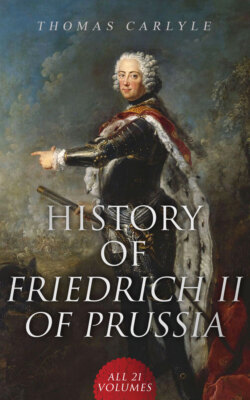Читать книгу History of Friedrich II of Prussia (All 21 Volumes) - Томас Карлейль - Страница 27
На сайте Литреса книга снята с продажи.
Chapter VII. — MARGRAVIATE OF CULMBACH: BAIREUTH, ANSPACH.
ОглавлениеTable of Contents
In the Year 1248, in his Castle of Plassenburg—which is now a Correction-House, looking down upon the junction of the Red and White Mayn—Otto Duke of Meran, a very great potentate, more like a King than a Duke, was suddenly clutched hold of by a certain wedded gentleman, name not given, "one of his domestics or dependents," whom he had enraged beyond forgiveness (signally violating the Seventh Commandment at his expense); and was by the said wedded gentleman there and then cut down, and done to death. "Lamentably killed, jammerlich erstochen," says old Rentsch. [P. 293. Kohler, Reichs-Historie, p. 245. Holle, Alte Geschichte der Stadt Baireuth (Baireuth, 1833), pp. 34–37.] Others give a different color to the homicide, and even a different place; a controversy not interesting to us. Slain at any rate he is; still a young man; the last male of his line. Whereby the renowned Dukes of Meran fall extinct, and immense properties come to be divided among connections and claimants.
Meran, we remark, is still a Town, old Castle now abolished, in the Tyrol, towards the sources of the Etsch (called ADIGE by Italian neighbors). The Merans had been lords not only of most of the Tyrol; but Dukes of "the Voigtland;"—Voigtland, that is BAILLIE-LAND, wide country between Nurnberg and the Fichtelwald; why specially so called, Dryasdust dimly explains, deducing it from certain Counts von Reuss, those strange Reusses who always call themselves HENRY, and now amount to HENRY THE EIGHTIETH AND ODD, with side-branches likewise called Henry; whose nomenclature is the despair of mankind, and worse than that of the Naples Lazzaroni who candidly have no names!—Dukes of Voigtland, I say; likewise of Dalmatia; then also Markgraves of Austria; also Counts of Andechs, in which latter fine country (north of Munchen a day's ride), and not at Plassenburg, some say, the man was slain. These immense possessions, which now (A.D. 1248) all fall asunder by the stroke of that sword, come to be divided among the slain man's connections, or to be snatched up by active neighbors, and otherwise disposed of.
Active Wurzburg, active Bamberg, without much connection, snatched up a good deal: Count of Orlamunde, married to the eldest Sister of the slain Duke, got Plassenburg and most of the Voigtland: a Tyrolese magnate, whose Wife was an Aunt of the Duke's, laid hold of the Tyrol, and transmitted it to daughters and their spouses—the finish of which line we shall see by and by:—in short, there was much property in a disposable condition. The Hohenzollern Burggraf of Nurnberg, who had married a younger Sister of the Duke's two years before this accident, managed to get at least BAIREUTH and some adjacencies; big Orlamunde, who had not much better right, taking the lion's share. This of Baireuth proved a notable possession to the Hohenzollern family: it was Conrad the first Burggraf's great-grandson, Friedrich, counted "Friedrich III." among the Burggraves, who made the acquisition in this manner, A.D. 1248.
Onolzbach (On'z-BACH or "-brook," now called ANSPACH) they got, some fourscore years after, by purchase and hard money down ("24,000 pounds of farthings," whatever that may be), [A.D. 1331: Stadt Anspach, by J. B. Fischer (Anspach, 1786), p. 196.] which proved a notable twin possession of the family. And then, in some seven years more (A.D. 1338), the big Orlamunde people, having at length, as was too usual, fallen considerably insolvent, sold Plassenburg Castle itself, the Plassenburg with its Town of Culmbach and dependencies, to the Hohenzollern Burggraves, [Rentsch, p. 157.] who had always ready money about them. Who in this way got most of the Voigtland, with a fine Fortress, into hand; and had, independently of Nurnberg and its Imperial properties, an important Princely Territory of their own. Margraviate or Principality of CULMBACH (Plassenburg being only the Castle) was the general title; but more frequently in later times, being oftenest split in two between brothers unacquainted with primogeniture, there were two Margraviates made of it: one of Baireuth, called also "Margraviate On the Hill;" and one of Anspach, "Margraviate Under the Hill:" of which, in their modern designations, we shall by and by hear more than enough.
Thus are the Hohenzollern growing, and never declining: by these few instances judge of many. Of their hard labors, and the storms they had to keep under control, we could also say something: How the two young Sons of the Burggraf once riding out with their Tutor, a big hound of theirs in one of the streets of Nurnberg accidentally tore a child; and there arose wild mother's-wail; and "all the Scythe-smiths turned out," fire-breathing, deaf to a poor Tutor's pleadings and explainings; and how the Tutor, who had ridden forth in calm humor with two Princes, came galloping home with only one—the Smiths having driven another into boggy ground, and there caught and killed him; [Rentsch, p. 306 (Date not given; guess, about 1270).] with the Burggraf's commentary on that sad proceeding (the same Friedrich III. who had married Meran's Sister); and the amends exacted by him, strict and severe, not passionate or inhuman. Or again how the Nurnbergers once, in the Burggraf's absence, built a ring-wall round his Castle; entrance and exit now to depend on the Nurnbergers withal! And how the Burggraf did not fly out into battle in consequence, but remedied it by imperturbable countenance and power of driving. With enough of the like sort; which readers can conceive.
